A Simulation Study on Peak Carbon Emission of Public Buildings—In the Case of Henan Province, China
Abstract
1. Introduction
2. Literature Review
2.1. Research on Influencing Factors of Carbon Emission of Public Buildings
2.2. Research on Carbon Emission Model of Public Buildings
3. Data Sources
4. Energy Consumption Calculation Methods
4.1. Building Energy Consumption Analysis
4.2. Analysis of Energy Consumption in Public Buildings
4.3. Basic Calculations
5. Calculation of Carbon Emissions
5.1. Construction of Kaya–LMDI Model
5.2. Calculation Methods of Total Carbon Emission and Carbon Emission Intensity
5.3. Analysis Results of the Kaya–LMDI Decomposition Method
- (1)
- Per capita area of public buildings and urban and rural population structure has a significant effect on the carbon emission of public buildings in Henan Province, with an increasing effect year by year. Due to the impact of the Covid pandemic, the growth trend of carbon emissions from public buildings in industry and services significantly slowed down in 2020.
- (2)
- In recent years, the carbon emissions from public buildings have been increasing yearly with the expansion of building scale. In order to facilitate the “carbon peak and carbon neutrality”, Henan Province has issued the 13th Five-Year Energy Development Plan to implement low-carbon and green transformation strategies and explore green development models for various industries (Table 3) [53,54]. As a result, the influencing coefficient of energy intensity per unit area of public buildings significantly decreases.
6. Analysis of Influencing Factors
- (1)
- Population size, public floor area per capita, urbanisation rate, and energy intensity per unit of public floor area have a significant effect on carbon emissions from public buildings.
- (2)
- Energy emission factors continuously increase, with significant emission reductions occurring only in 2014 and 2020. This reduction trend also indirectly indicates the improvement of energy productivity, providing Henan Province with an ideological strategy to promote the “Double Carbon” path by focusing on improving energy efficiency and changing the energy structure.
- (3)
- Currently, the scale of services and public buildings and urbanisation rate are significantly increased. In addition, the implementation of policies such as the two-child policy has led to a slight increase in population size. These changes have significantly affected the public floor area per capita.
- (4)
- The values of influencing factors steadily increase from 2010–2019. However, the downward trend in 2020 shows that greenhouse gas emissions are effectively managed, demonstrating the effect of optimising the energy structure.
7. Peak Scenario Analysis Model
7.1. Static Scenario Analysis Model
7.2. Dynamic Scenario Analysis Model
7.3. Simulation Results of Carbon Emission Peaking in Buildings under Static and Dynamic Scenarios
8. Discussion and Conclusions
- (1)
- Based on the Kaya–LMDI decomposition method, this study reveals the influencing factors on the growth of carbon emission intensity from public buildings in Henan Province during 2010–2020. The increasing trend of public building emissions during this period is also evaluated. Carbon emissions increased from 1533 t in 2010 to 6561 t in 2020. The emergence of new buildings, such as office buildings, hotels, and shopping malls, has led to a rapid increase in energy consumption. In addition, the pursuit of a more comfortable living environment also increases energy consumption. According to the Kaya–LMDI model of energy consumption in Henan Province and the scenario prediction analysis, the main factors influencing the carbon emissions of public buildings are population size, public floor area per capita, urbanisation rate, and energy intensity per unit area of public buildings. The development of the tertiary sector, the expansion of the building area, and the increasing population size also significantly increase each parameter. Based on the technical system implemented in the current demonstration projects, the main technical paths for developing ultra-low energy buildings in China are as follows: Improve building insulation performance through efficient building envelope structure and overall building airtightness; improve overall building energy efficiency through reasonable optimisation of building energy consumption system to realise ultra-low energy consumption building.
- (2)
- This study adopts the “static + dynamic” scenario analysis model to simulate the trends of energy consumption intensity per unit of public building area, public building area per capita, and energy emission coefficient of public buildings in Henan Province from 2020 to 2050 under different static scenarios. The results show that the variation trajectory of future carbon emissions exhibits an inverted U-shaped curve, with an expected carbon emission peak in 2030 and a slow decline after that. Using the Monte Carlo model with 100,000 simulations at a 95% confidence level to predict the peak CO2 and the peak time. Based on the simulation results, the corresponding “Double Control” objectives are implemented, suggesting that Henan Province could achieve a carbon peak with 7423 t around 2035. In addition, the sensitivity uncertainty analysis shows that the factor with the most significant influence on the carbon peak from public buildings in Henan Province is the public floor area per capita, with a contribution rate of about 57%. The least influencing factor is the urbanisation rate. These results provide some theoretical references for further exploration of carbon emission pathways and subsequent energy-saving and emission-reduction strategies for public buildings in Henan Province.
- (3)
- From international experience, some developed regions have already established a relatively complete carbon tax subsidy policy. China should first strengthen the supervision of building operational performance based on the Public Building Construction Operational Performance Standards. In addition, demand-side emission reduction should be promoted to drive the supply-side green and low-carbon transformation. Energy system optimisation is essential for provinces with high energy consumption, such as Henan Province. In addition to energy saving and carbon reduction, it is also necessary to vigorously develop clean energy, thus facilitating overall structural optimisation and innovation. Finally, the maintenance of existing public buildings (such as the renovation of heating, lighting, cooling, and other facilities) should be implemented to stop energy-intensive industries and promote “Double Carbon” goals (carbon peak and carbon neutrality).
- (4)
- This study complements the knowledge of carbon estimation and maximum model research in Henan Province. However, due to limited data from the Energy Statistics Yearbook and the subjective nature of the variable selection in each scenario related to urban development planning, the accuracy of energy consumption data and the quantification of model parameters need to be further improved. At present, the emission factor method is the most common method of carbon accounting. According to the formula, the product of the emission factor and fossil fuel consumption is the total carbon emissions. However, there are some errors in emission factors and consumption statistics. Carbon emissions calculated based on the energy balance sheet can not only cover the energy consumption generated in the process of processing and conversion, but also avoid the double calculation of thermal power generation and heating. It is a common accounting method for carbon emissions accounting for energy consumption in provincial and urban areas. Therefore, it is particularly important to formulate an authoritative emission factor coefficient and strengthen the formulation of energy low heating value. The level of energy balance sheet preparation should be improved, and the statistical deviation of carbon emission data should be narrowed. Energy statistics of major emitters should be strengthened. Rational energy monitoring plans should be put in place. Energy data statistics of key emitters should be strengthened. The accuracy of carbon verification data should be improved to ensure that the construction of carbon data system is fair, standardized, and scientific.
Author Contributions
Funding
Conflicts of Interest
References
- Jiang, X.; Guan, D. Determinants of global CO2 emissions growth. Appl. Energy 2016, 184, 1132–1141. [Google Scholar] [CrossRef]
- Ma, M.; Cai, W. What drives the carbon mitigation in Chinese commercial building sector? Evidence from decomposing an extended Kaya identity. Sci. Total Environ. 2018, 634, 884–899. [Google Scholar] [CrossRef] [PubMed]
- Huang, L.; Krigsvoll, G.; Johansen, F.; Liu, Y.; Zhang, X. Carbon emission of global construction sector. Renew. Sustain. Energy Rev. 2017, 81, 1906–1916. [Google Scholar] [CrossRef]
- Liu, Y.; Guo, B.; Lu, M.; Zang, W.; Yu, T.; Chen, D. Quantitative distinction of the relative actions of climate change and human activities on vegetation evolution in the Yellow River Basin of China during 1981–2019. J. Arid Land 2023, 15, 91–108. [Google Scholar] [CrossRef]
- Li, Y. An empirical analysis of the impact of rail transit construction on urban consumption. J. Xinyang Norm. Univ. (Nat. Sci. Ed.) 2022, 35, 432–437. [Google Scholar]
- Wang, H.; Chen, W.; Shi, J. Low carbon transition of global building sector under 2- and 1.5-degree targets. Appl. Energy 2018, 222, 148–157. [Google Scholar] [CrossRef]
- Gan, L.; Liu, Y.; Shi, Q.; Cai, W.; Ren, H. Regional inequality in the carbon emission intensity of public buildings in China. Build. Environ. 2022, 225, 109657. [Google Scholar] [CrossRef]
- Wang, Y.; Liang, Y.; Shao, L. Regional differences and influencing factors of the carbon emission efficiency from public buildings in China. Front. Environ. Sci. 2022, 10, 962264. [Google Scholar] [CrossRef]
- Li, L.; Duan, M.; Gu, X.; Wang, Y. The stimulation and coordination mechanisms of the carbon emission trading market of public buildings in China. Front. Energy Res. 2021, 9, 715504. [Google Scholar] [CrossRef]
- Ma, M.; Ma, X.; Cai, W.; Cai, W. Carbon-dioxide mitigation in the residential building sector: A household scale-based assessment. Energy Convers. Manag. 2019, 198, 111915. [Google Scholar] [CrossRef]
- Lu, M.; Lai, J. Review on carbon emissions of commercial buildings. Renew. Sustain. Energy Rev. 2020, 119, 109545. [Google Scholar] [CrossRef]
- Wang, P.; Yang, Y.; Ji, C.; Huang, L. Influence of built environment on building energy consumption: A case study in Nanjing, China. Environ. Dev. Sustain. 2023. [Google Scholar] [CrossRef] [PubMed]
- Qiao, R.; Liu, T. Impact of building greening on building energy consumption: A quantitative computational approach. J. Clean. Prod. 2020, 246, 119020. [Google Scholar] [CrossRef]
- Li, R.; Yu, Y.; Cai, W.; Liu, Q.; Liu, Y.; Zhou, H. Interprovincial differences in the historical peak situation of building carbon emissions in China: Causes and enlightenments. J. Environ. Manag. 2023, 332, 117347. [Google Scholar] [CrossRef] [PubMed]
- Liu, Q.; Xia, C.; Zhang, M. Research on the calculation and influencing factors of industrial green development efficiency in Henan Province. J. Xinyang Norm. Univ. (Nat. Sci. Ed.) 2021, 34, 394–400. [Google Scholar]
- Li, X.; Zhao, X. An empirical analysis on the impact of air pollution on green transportation consumption. J. Xinyang Norm. Univ. (Nat. Sci. Ed.) 2022, 35, 591–596. [Google Scholar]
- Kaya, S.; Kaya, C. A new equation based on ionization energies and electron affinities of atoms for calculating of group electronegativity. Comput. Theor. Chem. 2015, 1052, 42–46. [Google Scholar] [CrossRef]
- Eskander, S.; Nitschke, J. Energy use and CO2 emissions in the UK universities: An extended Kaya identity analysis. J. Clean. Prod. 2021, 309, 127199. [Google Scholar] [CrossRef]
- Georgios, M.; Kristina, O.; Peter, R.; Jan, C. A strategy for reducing CO2 emissions from buildings with the Kaya identity—A Swiss energy system analysis and a case study. Energy Policy 2016, 88, 343–354. [Google Scholar]
- Ortega-Ruiz, G.; Mena-Nieto, A.; García-Ramos, J.E. Is India on the right pathway to reduce CO2 emissions? Decomposing an enlarged Kaya identity using the LMDI method for the period 1990–2016. Sci. Total Environ. 2020, 737, 139638. [Google Scholar] [CrossRef]
- Zhao, L.; Zhao, T.; Yuan, R. Scenario simulations for the peak of provincial household CO2 emissions in China based on the STIRPAT model. Sci. Total Environ. 2021, 809, 151098. [Google Scholar] [CrossRef] [PubMed]
- Wu, R.; Wang, J.; Wang, S.; Feng, K. The drivers of declining CO2 emissions trends in developed nations using an extended STIRPAT model: A historical and prospective analysis. Renew. Sustain. Energy Rev. 2021, 149, 111328. [Google Scholar] [CrossRef]
- Ma, M.; Yan, R.; Cai, W. An extended STIRPAT model-based methodology for evaluating the driving forces affecting carbon emissions in existing public building sector: Evidence from China in 2000—2015. Nat. Hazards 2017, 89, 741–756. [Google Scholar] [CrossRef]
- Zou, X.; Wang, R.; Hu, G.; Rong, Z.; Li, J. CO2 emissions forecast and emissions peak analysis in Shanxi Province, China: An application of the LEAP Model. Sustainability 2022, 14, 637. [Google Scholar] [CrossRef]
- Jia, D.; Li, C. Scenario prediction and decoupling analysis of carbon emission in Jiangsu Province, China. Technol. Forecast. Soc. Chang. 2022, 185, 122074. [Google Scholar]
- Mu, T.; Geng, G.; Wang, C.; Zou, R. Evaluation approach of terminal energy consumption of public buildings based on a standardized model. Indoor Built Environ. 2022, 31, 1066–1078. [Google Scholar] [CrossRef]
- Li, X.; Wang, J.; Zhang, M.; Ouyang, J.; Shi, W. Regional differences in carbon emission of China’sindustries and its decomposition effects. J. Clean. Prod. 2020, 270, 122528. [Google Scholar] [CrossRef]
- Peng, D.; Liu, H. Measurement and driving factors of carbon emissions from coal consumption in China based on the Kaya-LMDI model. Energies 2022, 16, 439. [Google Scholar] [CrossRef]
- Yang, J.; Cai, W.; Ma, M.; Li, L.; Liu, C.; Ma, X.; Li, L.; Chen, X. Driving forces of China’s CO2 emissions from energy consumption based on Kaya-LMDI methods. Sci. Total Environ. 2020, 711, 134569. [Google Scholar] [CrossRef]
- Yu, H.; Wang, J.; Cao, L.; Bai, R.; Wang, P. Effects of the number of simulation iterations and meshing accuracy in monte-carlo random finite-difference analysis. Front. Earth Sci. 2023, 10, 1041288. [Google Scholar] [CrossRef]
- Tahmasebinia, F.; Jiang, R.; Sepasgozar, S.; Wei, J.; Ding, Y.; Ma, H. Implementation of BIM energy analysis and monte carlo simulation for estimating building energy performance based on regression approach: A case study. Buildings 2022, 12, 449. [Google Scholar] [CrossRef]
- Zhou, G.; Wu, M.; Tai, Y. Spatio temporal pattern analysis of coupling and coordination between rural development and urbanization from the perspective of rural revitalization a case study of Henan Province. J. Xinyang Norm. Univ. (Nat. Sci. Ed.) 2021, 34, 68–75. [Google Scholar]
- Xu, J.; Chen, Z. Research progress on urbanization affecting carbon emission. J. Hubei Univ. Econ. 2022, 20, 83–97. [Google Scholar]
- Wang, Y.; Liang, Y.; Shao, L. Driving factors and peak forecasting of carbon emissions from public buildings based on LMDI-SD. Discret. Dyn. Nat. Soc. 2022, 2022, 4958660. [Google Scholar] [CrossRef]
- Huang, H.; Wang, H.; Hu, Y.; Li, C.; Wang, X. Optimal plan for energy conservation and CO2 emissions reduction of public buildings considering users’ behavior: Case of China. Energy 2022, 261, 125037. [Google Scholar] [CrossRef]
- Liu, K.; Tian, J.; Chen, J.; Wen, Y. Low-Carbon retrofitting path of existing public buildings: A comparative study based on green building rating systems. Energies 2022, 15, 8724. [Google Scholar] [CrossRef]
- Kaya, Y. Impact of carbon dioxide emission on GNP growth: Interpretation of proposed scenarios. In Response Strategies Working Group; IPCC: Geneva, Switzerland, 1989. [Google Scholar]
- Liu, H.; Zhang, J.; Yuan, J. Can China achieve its climate pledge: A multi-scenario simulation of China’s energy-related CO2 emission pathways based on Kaya identity. Environ. Sci. Pollut. Res. Int. 2022, 29, 74480–74499. [Google Scholar] [CrossRef]
- Peng, C.; Wei, Q.; Wei, W. Decarbonization path of China’s public building sector from bottom to top. Carbon Neutrality 2022, 1, 39. [Google Scholar] [CrossRef]
- Chen, Y.; Wu, Y.; Chen, N.; Kang, C.; Du, J.; Luo, C. Calculation of energy consumption and carbon emissions in the construction stage of large public buildings and an analysis of influencing factors based on an improved STIRPAT model. Buildings 2022, 12, 2211. [Google Scholar] [CrossRef]
- Zhao, L.; Pan, W.; Lin, H. Can Fujian achieve carbon peak and pollutant reduction targets before 2030? Case study of 3E system in southeastern China based on system dynamics. Sustainability 2022, 14, 11364. [Google Scholar] [CrossRef]
- Raza, M.; Lin, B. Analysis of Pakistan’s electricity generation and CO2 emissions: Based on decomposition and decoupling approach. J. Clean. Prod. 2022, 359, 132074. [Google Scholar] [CrossRef]
- Chen, J.; Li, Z.; Dong, Y.; Song, M.; Muhammad, S.; Xie, Q. Coupling coordination between carbon emissions and the eco-environment in China. J. Clean. Prod. 2020, 276, 123848. [Google Scholar] [CrossRef]
- Zhang, G.; Sandanqyake, M.; Setunge, S.; Li, C.; Fang, J. Selection of emission factor standards for estimating emissions from diesel construction equipment in building construction in the Australian context. J. Environ. Manag. 2017, 187, 527–536. [Google Scholar] [CrossRef] [PubMed]
- State Administration for Market Regulation. General Principles of Energy Consumption Calculation Comprehensive; China Statistics Press: Beijing, China, 2021. [Google Scholar]
- Korolija, I.; Zhang, Y.; Marjanovic-Halburd, L.; Hanby, V.I. Regression models for predicting UK office building energy consumption from heating and cooling demands. Energy Build. 2013, 59, 214–227. [Google Scholar] [CrossRef]
- Cai, W.; Pang, T.; Lang, N.; Zhao, Y.; Wu, Y. Calculation and analysis of provincial building energy consumption in China. HVAC 2020, 50, 66–71+116. [Google Scholar]
- Xie, J. Discussion on Peak Carbon Emissions and Energy Saving-Emission Reduction of Public Buildings in Chongqing Based on LEAP Model; University of Chongqing: Chongqing, China, 2019. [Google Scholar]
- Lin, B.; Liu, H. China’s building energy efficiency and urbanization. Energy Build. 2015, 86, 356–365. [Google Scholar] [CrossRef]
- Institute of Standards and Quotations, Ministry of Housing and Urban-Rural Development. Strategies for Controlling the Total Energy Consumption of Civil Buildings in China; China Construction Industry Press: Beijing, China, 2016. [Google Scholar]
- Song, M.; Liu, X.; Hu, S. Building a greener future—Progress of the green building technology in the “13th Five-Year Plan” of China, Building simulation. Build. Simul. 2022, 15, 1705–1707. [Google Scholar] [CrossRef]
- Bai, L. Quantitative analysis of building carbon emissions and research on emission reduction counterm easures in Henan Province under the double carbon target. Henan Sci. Technol. 2022, 41, 129–132. [Google Scholar] [CrossRef]
- Zhai, H.; Zhang, Z.; Zhao, X.; Xie, W.; Chen, Q.; Hu, Y. Optimization of green infrastructure in Xinyang City based on network structure analysis. J. Xinyang Norm. Univ. (Nat. Sci. Ed.) 2021, 34, 260–266. [Google Scholar]
- Guo, B.; Lu, M.; Fan, Y.; Wu, H.; Yang, Y.; Wang, C. A novel remote sensing monitoring index of salinization based on three-dimensional feature space model and its application in the Yellow River Delta of China. Geomatics. Nat. Hazards Risk 2023, 14, 95–116. [Google Scholar] [CrossRef]
- Wang, X. Study on the Influencing fa Actors and Prediction of Civil Building Floor Space in China; Tianjin University: Tianjin, China, 2020. [Google Scholar]
- Cong, X. Study of Carbon Dioxide Emissions of Buildings in Different Regions of China Based on Climatic Factors; Dalian University of Technology: Dalian, China, 2014. [Google Scholar]
- McNeil, M.; Feng, W.; du Can, S.; Khanna, N.; Ke, J.; Zhou, N. Energy efficiency outlook in China’s urban buildings sector through 2030. Energy Policy 2016, 97, 532–539. [Google Scholar] [CrossRef]
- Hong, L. Building stock dynamics and its impacts on materials and energy demand in China. Energy Policy 2016, 94, 47–55. [Google Scholar] [CrossRef]
- Ma, M. Impact Factors and Peaking Simulation of Carbon Emissions in the Chinese Building Sector; Chongqing University: Chongqing, China, 2020. [Google Scholar]
- Peng, F. Short-term carbon emission prediction method of green building based on IPAT model. Int. J. Glob. Energy Issues 2023, 45, 1–13. [Google Scholar]
- Zhang, S.; Wang, K.; Yang, X.; Xu, W. Research on emission goal of carbon peak and carbon neutral in building sector. Build. Sci. 2021, 37, 189–198. [Google Scholar]
- Dong, K.; Jiang, H.; Sun, R.; Dong, X. Driving forces and mitigation potential of global CO2 emissions from 1980 through 2030: Evidence from countries with different income levels. Sci. Total Environ. 2019, 649, 335–343. [Google Scholar] [CrossRef]
- Li, B.; Liang, Q.; Wang, J. A comparative study on prediction methods for China’s medium-and long-term coal demand. Energy 2015, 93, 1671–1683. [Google Scholar] [CrossRef]
- Shao, S.; Zhang, X.; Zhao, X. Empirical decomposition and peaking pathway of carbon dioxide emissions of China’s manufacturing sector-generalized divisia index method and dynamic scerhario analysis. China Ind. Econ. 2017, 3, 44–63. [Google Scholar]
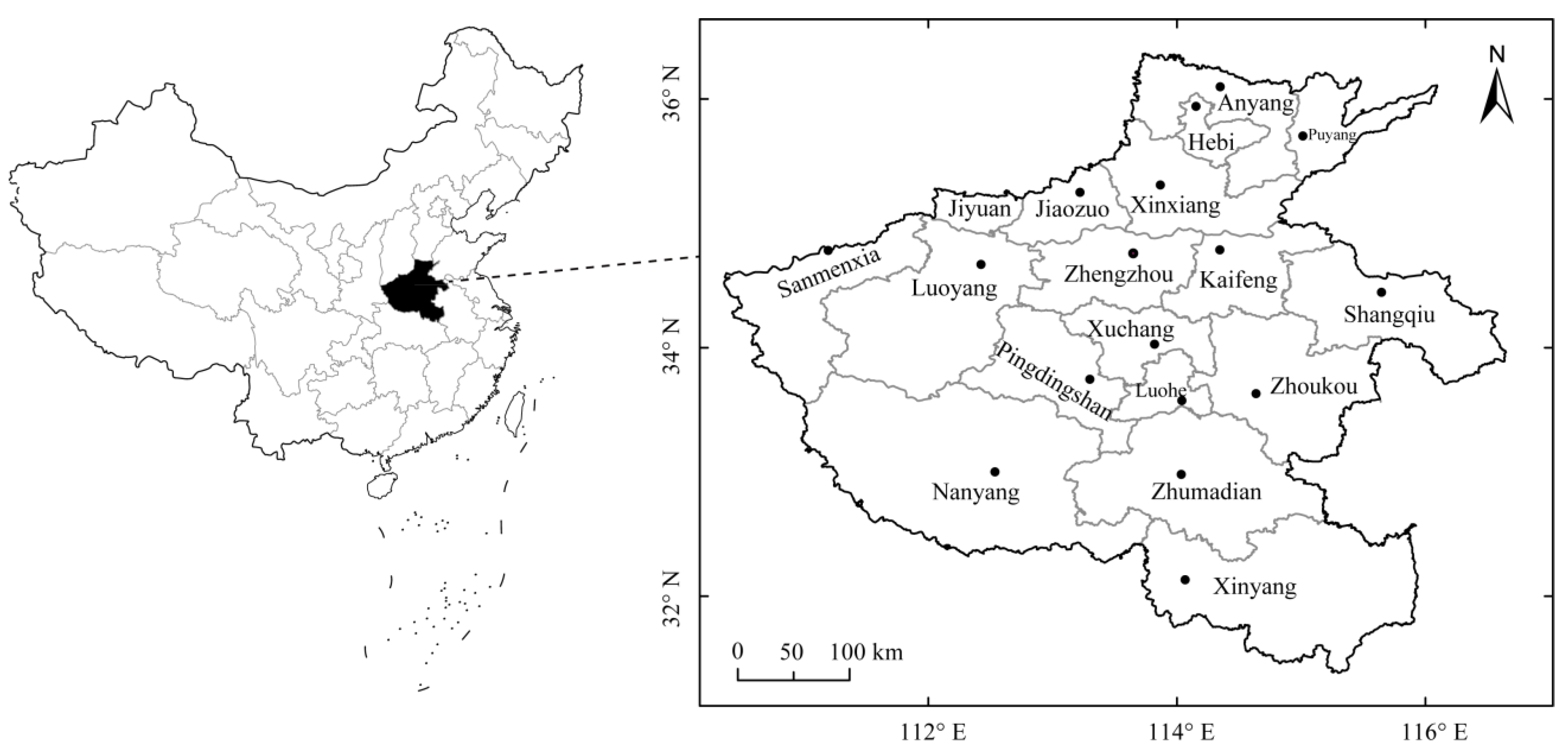
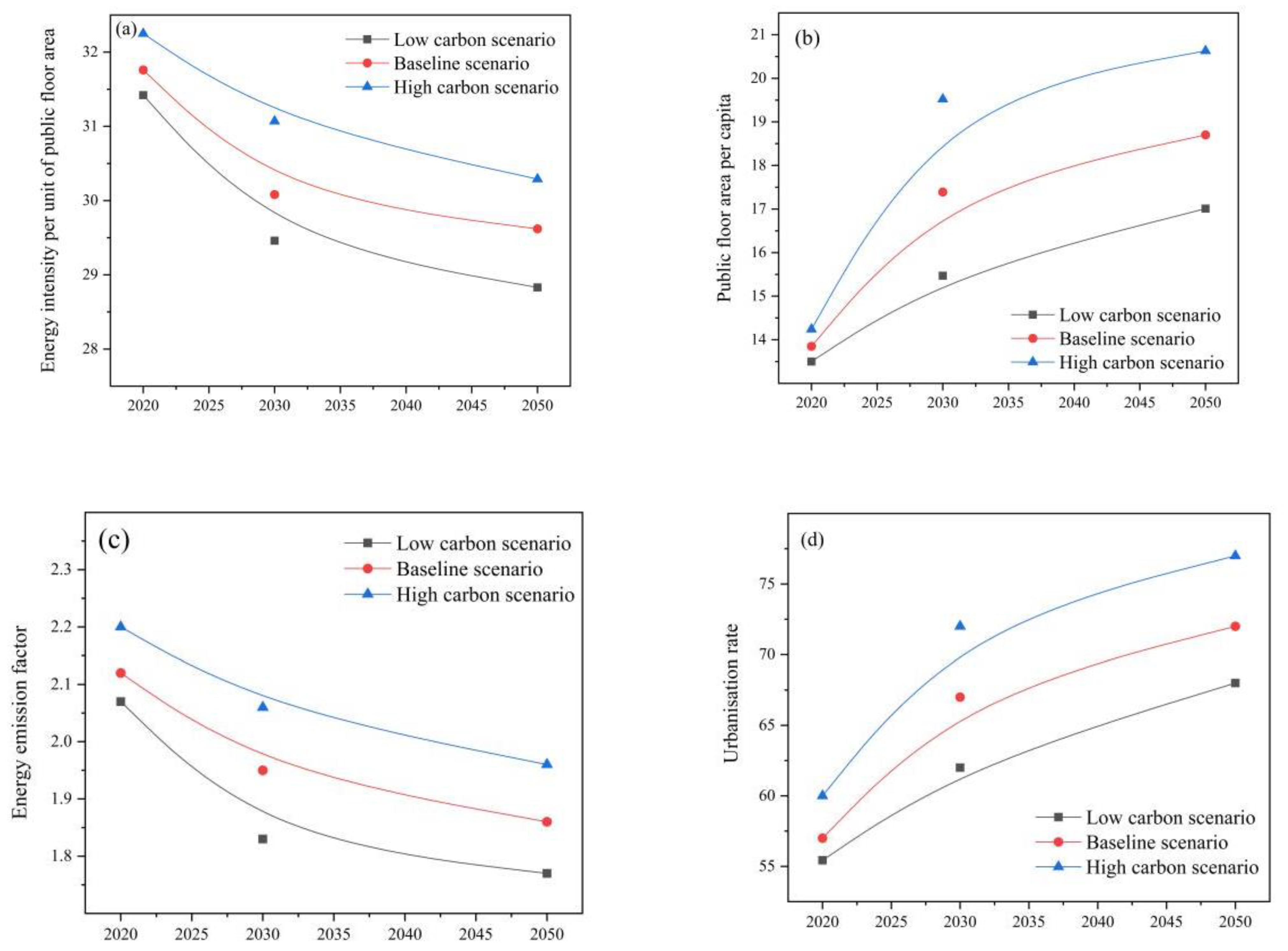
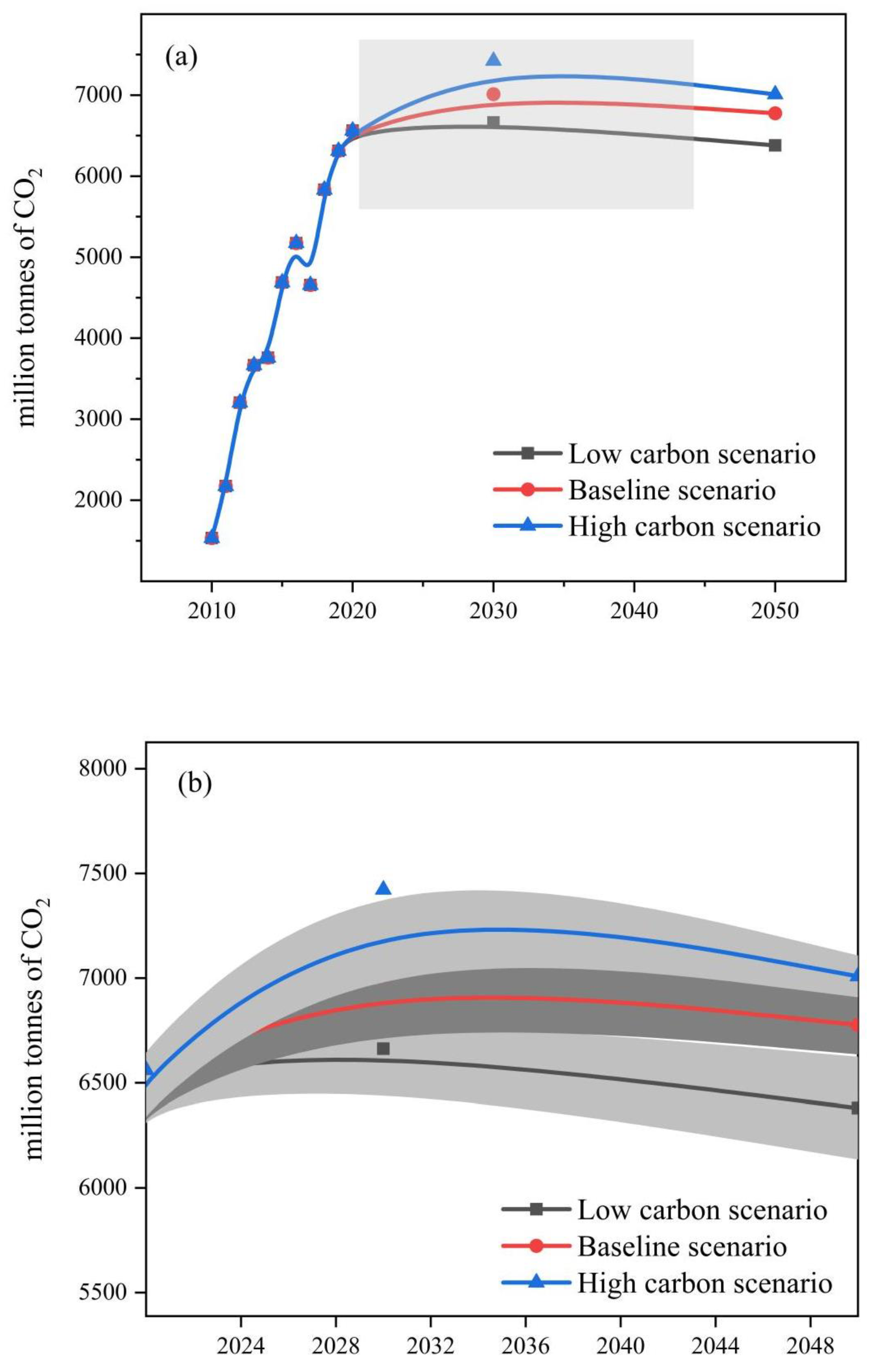
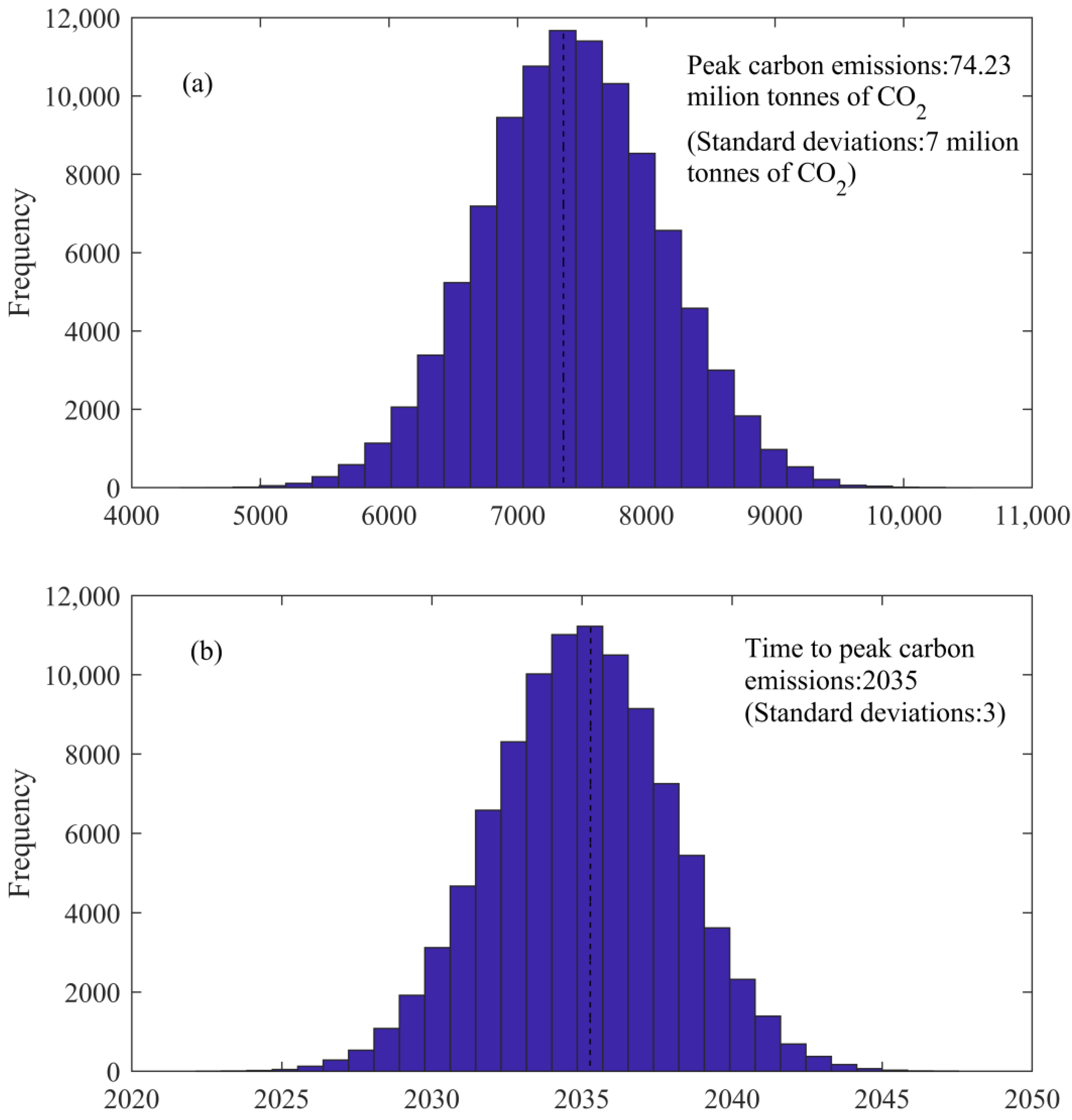
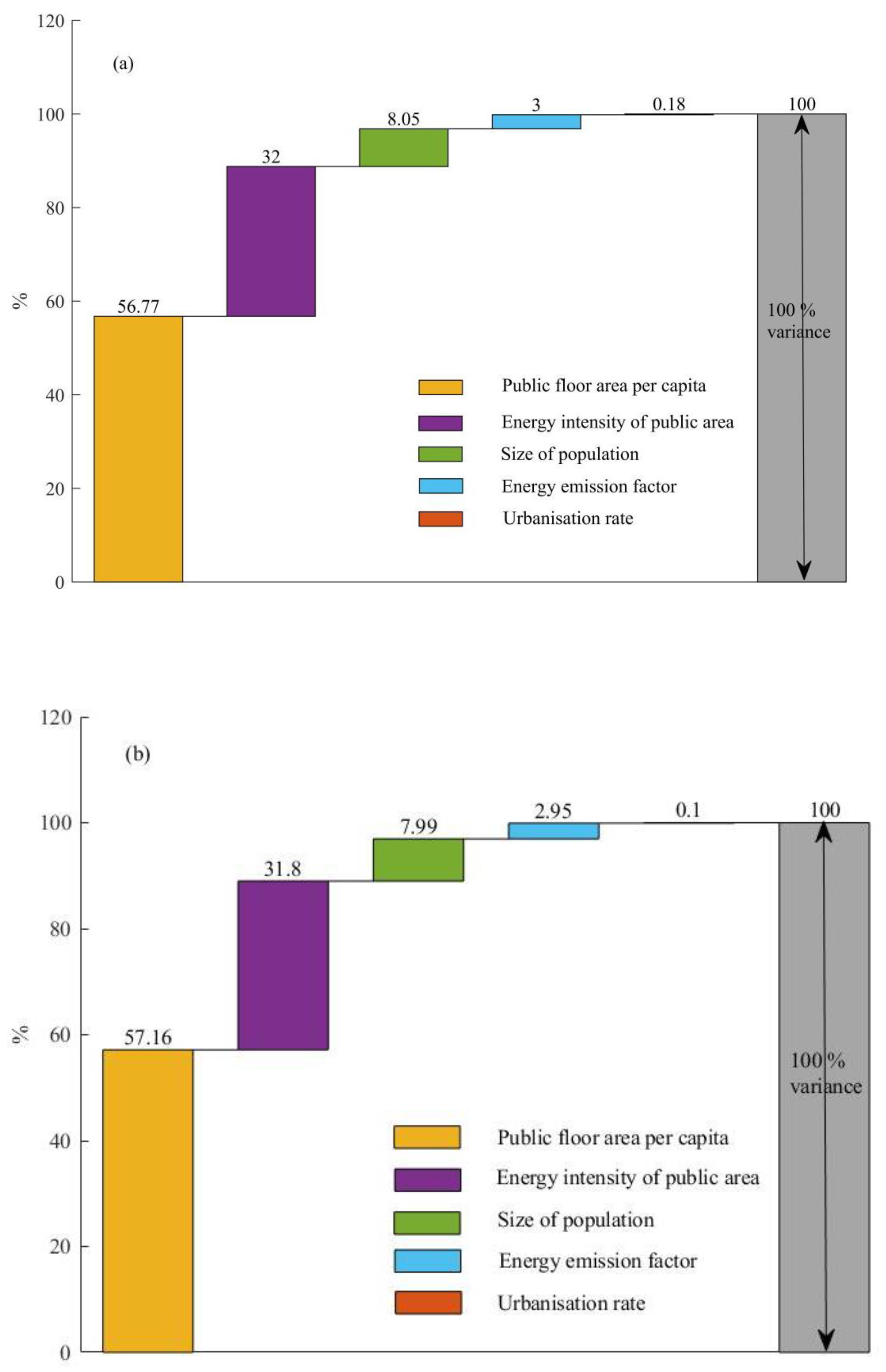
| Year | Building Energy Consumption | Public Building Energy Consumption | Year | Building Energy Consumption | Public Building Energy Consumption |
|---|---|---|---|---|---|
| 2010 | 3488.95 | 1129.14 | 2016 | 5448.55 | 2279.91 |
| 2011 | 4489.10 | 1445.25 | 2017 | 5365.48 | 1968.87 |
| 2012 | 5123.07 | 1581.14 | 2018 | 6212.64 | 2426.85 |
| 2013 | 4585.25 | 1730.65 | 2019 | 6529.69 | 2704.42 |
| 2014 | 4999.36 | 2072.11 | 2020 | 6784.10 | 2852.62 |
| 2015 | 5357.71 | 2082.19 |
| Number | Energy Name | Converted Standard Coal Coefficient |
|---|---|---|
| 1 | Raw coal (ton) | 0.71 |
| 2 | Liquefied petroleum gas (ton) | 1.71 |
| 3 | Natural gas (10,000 m3) | 13.30 |
| 4 | Thermal power (million kJ) | 0.03 |
| 5 | Electricity (10,000 kWh) | 1.23 |
| Year | |||||
|---|---|---|---|---|---|
| 2011 | 189.00 | 323.14 | 32.85 | 76.40 | 20.62 |
| 2012 | 908.67 | 67.51 | 490.32 | 177.96 | 27.54 |
| 2013 | 1088.27 | 199.59 | 507.51 | 284.09 | 53.55 |
| 2014 | 719.26 | 514.13 | 554.78 | 369.39 | 68.45 |
| 2015 | 1427.70 | 390.30 | 689.16 | 540.91 | 106.93 |
| 2016 | 1537.73 | 549.75 | 715.97 | 683.60 | 153.95 |
| 2017 | 1559.98 | −14.37 | 688.30 | 742.78 | 146.31 |
| 2018 | 1837.91 | 489.22 | 831.08 | 955.41 | 186.37 |
| 2019 | 1829.56 | 743.63 | 882.71 | 1115.15 | 207.96 |
| 2020 | 1822.97 | 1169.00 | 579.28 | 1231.78 | 224.99 |
| Year | 2010 | 2011 | 2012 | 2013 | 2014 | 2015 | 2016 | 2017 | 2018 | 2019 | 2020 |
|---|---|---|---|---|---|---|---|---|---|---|---|
| Population size (10,000 people) | 10,800 | 10,922 | 10,932 | 11,039 | 11,102 | 11,217 | 11,370 | 11,377 | 11,444 | 11,486 | 11,526 |
| Urbanisation rate (%) | 38.82 | 40.47 | 41.99 | 43.6 | 45.05 | 47.02 | 48.78 | 50.56 | 52.24 | 54.01 | 55.43 |
| Energy emission factor (tCO2/tce) | 1.36 | 1.50 | 2.03 | 2.12 | 1.81 | 2.25 | 2.27 | 2.36 | 2.4 | 2.33 | 2.30 |
| Energy consumption intensity per unit of public floor area (kgce/m2) | 23.00 | 27.42 | 23.69 | 24.95 | 28.29 | 26.41 | 27.63 | 22.88 | 26.77 | 28.66 | 32.25 |
| Public floor area per capita (m2/person) | 11.71 | 11.92 | 14.54 | 14.41 | 14.65 | 14.95 | 14.88 | 14.96 | 15.16 | 15.21 | 13.85 |
| Public floor area (10,000 m2) | 49,100 | 52,700 | 66,737.84 | 69,360.46 | 73,245.18 | 78,849.56 | 82,506.15 | 86,054.17 | 90,646.32 | 94,356.06 | 88,465.32 |
| Parameters | Low Carbon Scenario | Baseline Scenario | High Carbon Scenario | |||
|---|---|---|---|---|---|---|
| Year | 2030 | 2050 | 2030 | 2050 | 2030 | 2050 |
| Population size (10,000 people) | 12,726 | 11,806 | 12,726 | 11,806 | 12,726 | 11,806 |
| Urbanisation rate (%) | 62 | 68 | 67 | 72 | 72 | 77 |
| Energy emission factor (tCO2/tce) | 1.83 | 1.77 | 1.95 | 1.86 | 2.06 | 1.96 |
| Energy consumption intensity per unit of public floor area (kgce/m2) | 29.46 | 28.83 | 30.08 | 29.02 | 31.07 | 30.29 |
| Public floor area per capita (m2/person) | 15.47 | 17.01 | 17.39 | 18.7 | 19.52 | 20.63 |
| Variables | Random Distribution of Future Variables |
|---|---|
| Population size (10,000 people) | N (0, 0.005) |
| Urbanisation rate (%) | N (0, 0.02) |
| Energy emission factor (tCO2/tce) | N (0, 0.01) |
| Energy consumption intensity per unit of public floor area (kgce/m2) | N (0, 0.04) |
| Public floor area per capita (m2/person) | N (0, 0.05) |
Disclaimer/Publisher’s Note: The statements, opinions and data contained in all publications are solely those of the individual author(s) and contributor(s) and not of MDPI and/or the editor(s). MDPI and/or the editor(s) disclaim responsibility for any injury to people or property resulting from any ideas, methods, instructions or products referred to in the content. |
© 2023 by the authors. Licensee MDPI, Basel, Switzerland. This article is an open access article distributed under the terms and conditions of the Creative Commons Attribution (CC BY) license (https://creativecommons.org/licenses/by/4.0/).
Share and Cite
Li, H.; Zheng, Y.; Gong, G.; Guo, H. A Simulation Study on Peak Carbon Emission of Public Buildings—In the Case of Henan Province, China. Sustainability 2023, 15, 8638. https://doi.org/10.3390/su15118638
Li H, Zheng Y, Gong G, Guo H. A Simulation Study on Peak Carbon Emission of Public Buildings—In the Case of Henan Province, China. Sustainability. 2023; 15(11):8638. https://doi.org/10.3390/su15118638
Chicago/Turabian StyleLi, Hui, Yanan Zheng, Guan Gong, and Hongtao Guo. 2023. "A Simulation Study on Peak Carbon Emission of Public Buildings—In the Case of Henan Province, China" Sustainability 15, no. 11: 8638. https://doi.org/10.3390/su15118638
APA StyleLi, H., Zheng, Y., Gong, G., & Guo, H. (2023). A Simulation Study on Peak Carbon Emission of Public Buildings—In the Case of Henan Province, China. Sustainability, 15(11), 8638. https://doi.org/10.3390/su15118638





